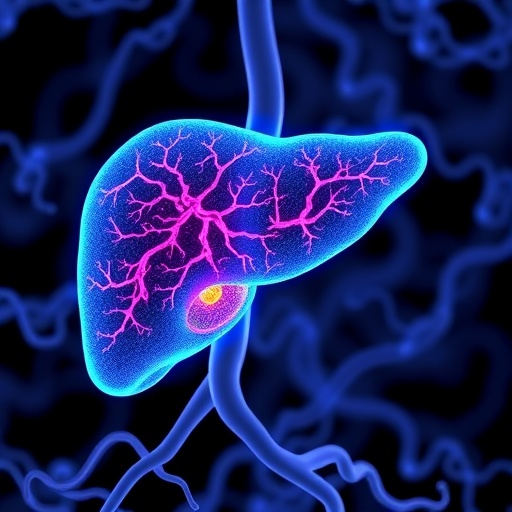Liver fibrosis remains a formidable challenge in contemporary medicine, arising from chronic hepatic injury that precipitates excessive extracellular matrix deposition. This pathological scar formation can culminate in cirrhosis and hepatocellular carcinoma, conditions that contribute significantly to global morbidity and mortality. Central to this fibrogenic cascade is Transforming Growth Factor-Beta (TGF-β), a multifunctional cytokine that orchestrates the activation and transdifferentiation of hepatic stellate cells into profibrotic myofibroblasts. Despite its pivotal role, clinical interventions specifically targeting TGF-β signaling in liver fibrosis have yet to enter routine practice, underscoring the urgency of developing effective therapeutics.
At a molecular level, TGF-β exerts its fibrotic influence through intricate signaling pathways. The canonical SMAD-dependent pathway is initiated upon TGF-β ligand binding to serine/threonine kinase receptors, TβRII and TβRI (also known as ALK5). This triggers phosphorylation cascades involving SMAD2 and SMAD3, which form complexes with SMAD4 and translocate to the nucleus, where they regulate the transcription of fibrogenic genes, including those encoding collagen and other extracellular matrix components. This pathway remains tightly regulated by inhibitory SMAD proteins, such as SMAD6 and SMAD7, which act as critical brakes within the signaling network to prevent unchecked fibrosis.
Parallel to the canonical route, TGF-β activates multiple SMAD-independent pathways that amplify its fibrotic effects. These include the PI3K/Akt axis, mitogen-activated protein kinases (MAPKs) such as ERK, JNK, and p38, and TAK1 kinase. The convergence of these pathways modulates various cellular functions, including hepatic stellate cell proliferation, survival, epithelial-mesenchymal transition, and matrix remodeling. This multifaceted signaling complexity contributes to the robustness and redundancy of fibrogenic responses, posing significant barriers to therapeutic targeting without eliciting substantial off-target effects.
The therapeutic landscape aiming to disrupt TGF-β signaling is diverse and evolving. One primary avenue involves the use of monoclonal antibodies that directly neutralize TGF-β ligands, thus preventing receptor engagement and subsequent downstream signaling. Agents such as Fresolimumab (GC1008) and CAT-192 have demonstrated efficacy in fibrotic conditions outside of hepatology, yet their translation to liver fibrosis remains in early phase clinical evaluations. Concerns regarding systemic blockade of TGF-β stem from its vital roles in immune regulation and tissue homeostasis, which can be compromised leading to adverse effects.
Advancing precision in intervention, small-molecule inhibitors targeting the kinase activity of TGF-β receptors have garnered significant interest. Galunisertib (LY2157299) is a prototypic inhibitor of the TβRI receptor kinase domain that impedes SMAD phosphorylation, thereby curtailing downstream fibrotic gene expression. Clinical trials indicate that Galunisertib not only exhibits pronounced anti-fibrotic potential but may also improve survival outcomes in hepatocellular carcinoma patients, highlighting its dual antitumor and antifibrotic capabilities. Complementary molecules such as Vactosertib and integrin inhibitors like PLN-1474 further delineate the therapeutic diversity by modulating specific receptor interactions and activation states.
Emerging molecular modalities employ antisense oligonucleotides (ASOs) to selectively degrade TGF-β mRNA, thus reducing protein synthesis. Trabedersen (AP-12009) exemplifies this strategy, offering exquisite specificity with the potential for reduced systemic toxicity. Nonetheless, ASO-based therapies remain in nascent stages of research for liver fibrosis, with ongoing investigations required to clarify their pharmacodynamics, delivery mechanisms, and clinical efficacy.
Another therapeutic concept revolves around indirect suppression of TGF-β signaling through downstream pathway inhibition. Drugs such as Pirfenidone and its derivative Hydronidone have shown promise, with the latter demonstrating significant improvements in liver fibrosis markers when administered alongside antiviral agents like entecavir in chronic hepatitis B patients. These compounds likely modulate the fibrotic milieu by attenuating SMAD activity and associated proinflammatory cascades, underscoring the potential benefits of combination regimens.
An intriguing and rapidly expanding area of research is the potential of Traditional Chinese Medicine (TCM) in targeting liver fibrosis. Numerous phytochemicals, including alkaloids such as Piperine and Sinomenine, flavonoids like Chrysin and Quercetin, and terpenoids exemplified by Limonin and Andrographolide, exhibit anti-fibrotic effects through modulation of the TGF-β pathway. These compounds offer multifaceted mechanisms with lower toxicity profiles, presenting valuable leads for drug development. However, standardized clinical evaluations remain necessary to transition these agents from bench to bedside effectively.
Despite these advances, the clinical translation of TGF-β-targeting agents faces profound challenges. The paradoxical role of TGF-β as a tumor suppressor in early disease stages versus a fibrosis and tumor promoter in later stages complicates therapeutic timing and patient selection. Moreover, systemic inhibition can disrupt critical physiological functions, including immune tolerance and tissue repair, leading to autoimmunity and impaired healing. Such risks necessitate the development of highly selective, isoform-specific inhibitors or targeted delivery systems, potentially through nanoparticle technologies, to minimize off-target effects.
Future directions emphasize the integration of combination therapies aimed at concurrently modulating multiple fibrogenic pathways. Co-targeting TGF-β alongside complementary signaling networks may enhance antifibrotic efficacy, overcome resistance mechanisms, and mitigate adverse outcomes. Additionally, rigorous pharmacological characterization and clinical validation of TCM-derived compounds could enrich the therapeutic arsenal, capitalizing on their versatility and historical medicinal use.
Ultimately, the intricate understanding of TGF-β as a master regulator in liver fibrosis provides a blueprint for innovative therapeutic strategies. This comprehensive approach, supported by molecular insights, translational research, and natural product pharmacology, charts a promising pathway toward effective, targeted treatments capable of halting or reversing liver fibrogenesis. The advent of such therapies has the potential to revolutionize clinical management and patient prognosis in hepatic fibrosis and its sequelae.
Subject of Research: Liver Fibrosis and Transforming Growth Factor-Beta (TGF-β) Signaling Pathways
Article Title: Exploring the Therapeutic Potential of TGF-β Inhibitors for Liver Fibrosis: Targeting Multiple Signaling Pathways
News Publication Date: 15-Jul-2025
Web References: https://www.xiahepublishing.com/journal/jcth, http://dx.doi.org/10.14218/JCTH.2025.00029
Image Credits: Lingying Huang, Zhi Shang
Keywords: Fibrosis, Enzyme inhibitors




